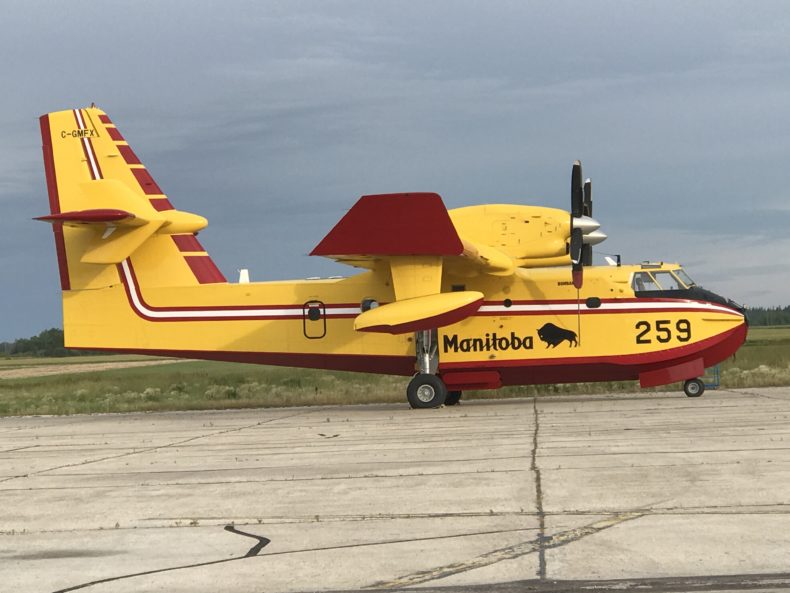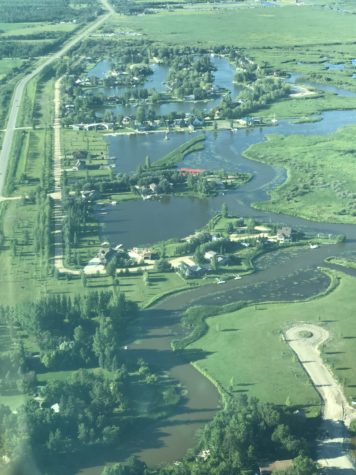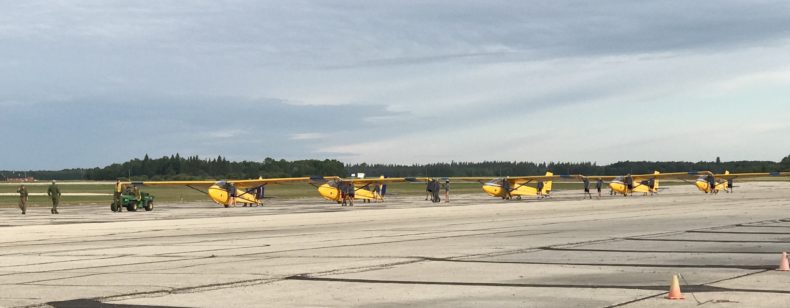
The iPad on my brother’s lap shows our plane as an icon moving across the landscape. Through our headsets, my brother explains that the circle surrounding the plane on the map represents our gliding range. Anything outside that circle would be too far for the single-engine Mooney to reach if all went suddenly silent. So a pilot always has to have a potential landing spot picked out in the fields and forests below, and then replace that spot with another as soon as it passes out of gliding range.
We are on our way from Ottawa, Ontario to Regina, Saskatchewan, but our journey will be punctuated with an overnight stay in the village of Gimli, Manitoba. The name was chosen by the Icelandic immigrants who populate the community, borrowing the term from the Norse mythological golden-roofed building where the survivors of Ragnarok will live. Home to only a couple of thousand souls, Gimli is known for two things: its annual Icelandic festival, which we will miss by just a couple of days, and the Gimli Glider.
On July 23, 1983, the Gimli airfield had long been converted from a Royal Canadian Air Force (RCAF) station into a motorsport complex, complete with race course, go-kart track and drag strip. A car race was taking place that day on part of the decommissioned runway, and people from Winnipeg had driven to Gimli, parking their campers by the side of the tarmac.
Two boys pedaled their bicycles at the end of the landing strip. Then silently, and with no warning, a Boeing 767 hurtled down to land. The pilot was so close he could see the boys’ terrified expressions. There were 69 people aboard.

The ordeal in the air began 17 minutes earlier over Red Lake, Ontario with a rapid series of events: fuel pressure alarms, a failed engine, a plan to divert to Winnipeg and make a one-engine landing. Then a “bong” sound that none of the crew recognized, as it had never been demonstrated in flight simulator training. The sound for “all-engine failure.”
At 40,000 feet, the pilots flipped through the checklist for instructions on this no-engine scenario. There were none. No such section existed. The plane lost all its power. Almost all of the instruments in the cockpit, powered by electricity from the working jets, went blank, including the vertical speed indicator, which is supposed to tell you just what its name suggests.
This is when First Officer Quintal had a bright idea – Gimli had been his station when he had been a pilot in the RCAF. It should be within gliding range, and 48-year-old Captain Bob Pearson happened to be a particularly experienced glider pilot. They had no idea the airfield had been decommissioned.
None of this, of course, should be happening. The plane was brand spanking new, although its fuel gauges weren’t working at the time. It later emerged that the fueling crew in Montreal had made a volume calculation error, using pounds instead of kilograms. This meant the plane only carried less than half of the fuel it was supposed to. It had just plumb run out of fuel in the middle of the sky.
The Gimli Glider came in for landing and braked as quickly as it could, blowing out tires and busting the nose cone. Everyone on the ground and in the plane survived, with no serious injuries. The plane went on to fly for Air Canada for another 25 years. When it was finally retired, Captain Pearson, First Officer Quintal and three of the six flight attendants from that fateful flight were aboard, chaperoning its journey to the Mojave desert.
Gimli’s airstrip is now reopened, and its most enthusiastic users are air cadets in the appropriately named Gimli Gliding School.

Photos by me.
I didn’t know about identifying gliding landing sites during the flight. I’m guessing there was a list of fixes following this adventure. Do they still use the “bong” sound? The first thing that popped into my head was the Gong Show. I also know it’s sometimes used to announce an elevator. Neither association seems very appropriate, considering the situation. Glad to read that all survived.
HAHA. “Ping!” Going down. Great questions. I know the pilot and first officer were both demoted/suspended following the incident for having let it happen, but then received airmanship awards. All kinds of mixed messages.
I read a great book which documents the Gimli Glider story:
https://www.amazon.com/Freefall-William-Hoffer/dp/0312029195